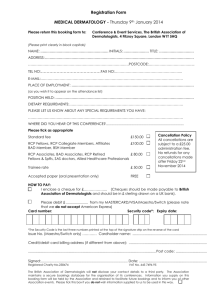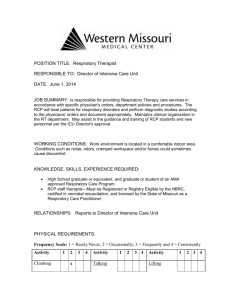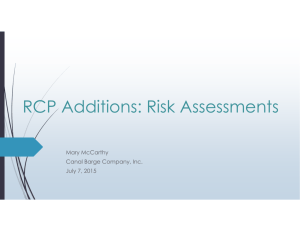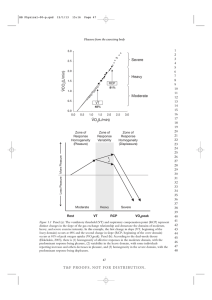Document 10948423
advertisement
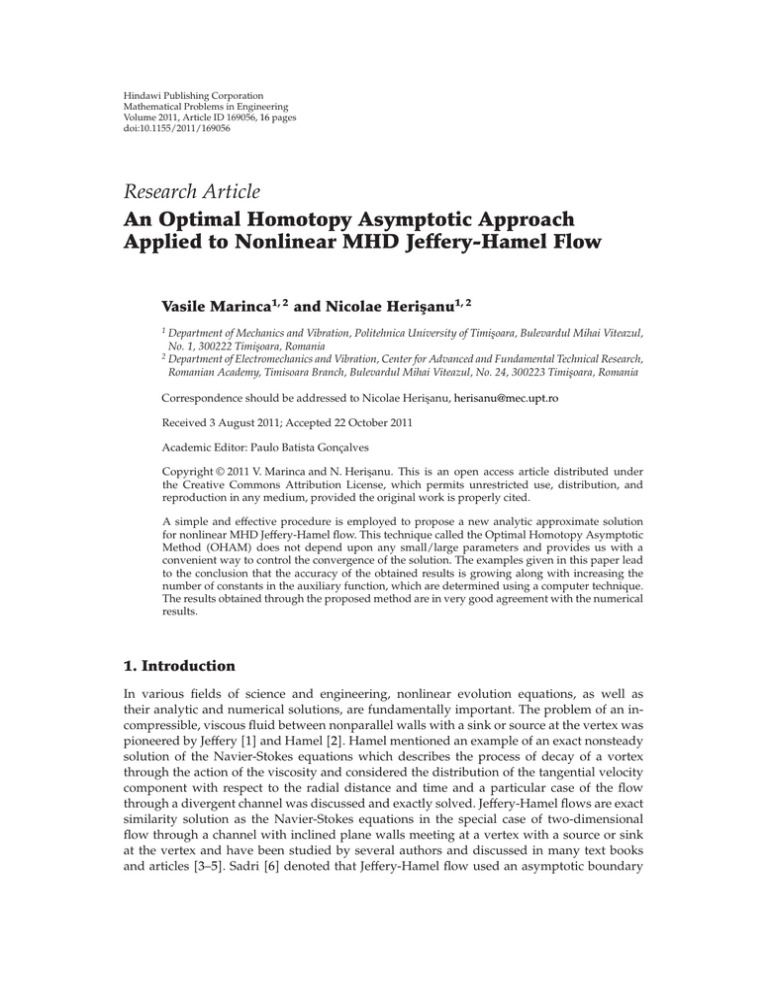
Hindawi Publishing Corporation Mathematical Problems in Engineering Volume 2011, Article ID 169056, 16 pages doi:10.1155/2011/169056 Research Article An Optimal Homotopy Asymptotic Approach Applied to Nonlinear MHD Jeffery-Hamel Flow Vasile Marinca1, 2 and Nicolae Herişanu1, 2 1 Department of Mechanics and Vibration, Politehnica University of Timişoara, Bulevardul Mihai Viteazul, No. 1, 300222 Timişoara, Romania 2 Department of Electromechanics and Vibration, Center for Advanced and Fundamental Technical Research, Romanian Academy, Timisoara Branch, Bulevardul Mihai Viteazul, No. 24, 300223 Timişoara, Romania Correspondence should be addressed to Nicolae Herişanu, herisanu@mec.upt.ro Received 3 August 2011; Accepted 22 October 2011 Academic Editor: Paulo Batista Gonçalves Copyright q 2011 V. Marinca and N. Herişanu. This is an open access article distributed under the Creative Commons Attribution License, which permits unrestricted use, distribution, and reproduction in any medium, provided the original work is properly cited. A simple and effective procedure is employed to propose a new analytic approximate solution for nonlinear MHD Jeffery-Hamel flow. This technique called the Optimal Homotopy Asymptotic Method OHAM does not depend upon any small/large parameters and provides us with a convenient way to control the convergence of the solution. The examples given in this paper lead to the conclusion that the accuracy of the obtained results is growing along with increasing the number of constants in the auxiliary function, which are determined using a computer technique. The results obtained through the proposed method are in very good agreement with the numerical results. 1. Introduction In various fields of science and engineering, nonlinear evolution equations, as well as their analytic and numerical solutions, are fundamentally important. The problem of an incompressible, viscous fluid between nonparallel walls with a sink or source at the vertex was pioneered by Jeffery 1 and Hamel 2. Hamel mentioned an example of an exact nonsteady solution of the Navier-Stokes equations which describes the process of decay of a vortex through the action of the viscosity and considered the distribution of the tangential velocity component with respect to the radial distance and time and a particular case of the flow through a divergent channel was discussed and exactly solved. Jeffery-Hamel flows are exact similarity solution as the Navier-Stokes equations in the special case of two-dimensional flow through a channel with inclined plane walls meeting at a vertex with a source or sink at the vertex and have been studied by several authors and discussed in many text books and articles 3–5. Sadri 6 denoted that Jeffery-Hamel flow used an asymptotic boundary 2 Mathematical Problems in Engineering condition to examine steady two-dimensional flow of a viscous fluid in a channel by means of certain symmetric solution of the flow although asymmetric solution are both possible and of physical interest 7. The classical Jeffery-Hamel problem was extended in 8 to include the effects of external magnetic field in conducted fluid. The magnetic field acts as a control parameter, along with the flow, Reynolds number, and the angle of the walls. Most scientific problems such as Jeffery-Hamel flows and other fluid mechanics problems are inherently nonlinear. Excepting a limited number of these problems, most do not have analytical solutions. Therefore, these nonlinear equations should be solved using other methods 9. The aim of the present work is to propose an accurate approach to the Jeffery-Hamel flow problem using an analytical technique, namely, OHAM 10, 11. The efficiency of our procedure, which does not require a small parameter in the equation, is based on the construction and determination of the auxiliary functions combined with a convenient way to optimally control the convergence of the solution. 2. Problem Statement and Governing Equation We consider a system of cylindrical polar coordinates r, θ, z with a steady two-dimensional flow of an incompressible conducting viscous fluid from a source or sink at channel walls lying in planes, with angle 2α, as shown in Figure 1. Assuming that the velocity is only along the radial direction and depends on r and θ, V ur, θ, 0 3–5, using the continuity Navier-Stokes equations in polar coordinates, the governing equations are ρ ∂ rur, θ 0, r ∂r 2.1 1 ∂p ∂2 ur, θ 1 ∂ur, θ 1 ∂2 ur, θ ur, θ ∂ur, θ , − v 2 − ur, θ ∂r ρ ∂r r ∂r ∂r 2 r ∂θ2 r2 − 1 ∂p 2v ∂ur, θ 0, ρr ∂ρ r 2 ∂θ 2.2 2.3 where ρ is the fluid density, p is the pressure, and v is the kinematic viscosity. From 2.1 and using dimensionless parameters we get fθ rur, θ, Fx fθ , fmax x 2.4 θ . α 2.5 Mathematical Problems in Engineering 3 α θ u(r, θ) Figure 1: Geometry of the Jeffery-Hamel flow problem. Substituting 2.5 into 2.2 and 2.3 and eliminating the pressure, we obtain an ordinary differential equation for the normalized function profile Fx: F x 2α Re FxF x 4α2 F x 0, 2.6 where prime denotes derivative with respect to x and the Reynolds number is αfmax umax Re v v divergent channel : α > 0, umax > 0 convergent channel : α < 0, umax < 0 2.7 and umax is the maximum velocity at the centre of the channel. The boundary conditions for 2.6 are F0 1, F 0 0, F1 0. 2.8 3. Fundamentals of the OHAM We consider the following nonlinear differential equation 10, 11: LFx fx NFx 0 3.1 subject to a boundary condition BF 0, 3.2 4 Mathematical Problems in Engineering where L is a linear operator, fx is a known analytical function, N is a nonlinear operator, and B is a boundary operator. By means of the OHAM one constructs a family of equations: 1 − p L φ x, p fx h x, p L φ x, p fx N φ x, p , 3.3 and the boundary condition is B φ x, p 0. 3.4 In 3.3, φx, p is an unknown function, p ∈ 0, 1 is an embedding parameter, and 0 for p / 0. When p increases hx, p is an auxiliary function such that hx, 0 0 and hx, p / from 0 to 1, the solution φx, p, changes from the initial approximation F0 x to the solution Fx. Obviously, when p 0 and p 1 it holds that φx, 0 F0 x, φx, 1 Fx. 3.5 Expanding φx, p in series with respect to the parameter p, one has φ x, p F0 x pF1 x p2 F2 x · · · . 3.6 If the initial approximation F0 x and the auxiliary function hx, p are properly chosen so that the series 3.6 converges at p 1, one has Fx F0 x F1 x F2 x . . . . 3.7 Notice that the series 3.6 contains the auxiliary function hx, p which determines their convergence regions. The results of the mth-order approximations are given by Fx ≈ F0 x F1 x F2 x · · · Fm x. 3.8 We propose an auxiliary function hx, p of the form h x, p pK1 x p2 K2 x · · · pm Km x, 3.9 where Ki x, i 1, 2, . . . , m can be functions on the variable x. Substituting 3.6 into 3.1 we obtain LFx fx NFx N0 F0 x pN1 F0 x, F1 x p2 N2 F0 x, F1 x, F2 x . . . . 3.10 If we substitute 3.9 and 3.10 into 3.3 and we equate to zero the coefficients of various powers of p, we obtain the following linear equations: LF0 x fx 0, BF0 x 0, 3.11 Mathematical Problems in Engineering LFi − LFi−1 − i j1 5 Kj Ni−j F0 , F1 , . . . , Fi−j 0, BFi 0, i 1, 2, . . . , m − 1 3.12 LFm − LFm−1 − m−1 j1 Kj Nm−1−j − Km N0 0, BFm 0. 3.13 At this moment, the mth-order approximate solution given by 3.8 depends on the functions K1 , K2 , . . ., Km . The constants C1 , C2 , . . ., Cq which appear in the expression of Ki x can be identified via various methodologies such as the least square method, the Galerkin method, and the collocation method. The constants C1 , C2 ,. . .,Cq could be determined, for example, if we substitute 3.8 into 3.1 resulting in the following residual: Rx, Ci L Fx, Ci fx N Fx, Ci , i 1, 2, . . . . 3.14 For xi ∈ a, b where a and b are two values depending on the given problem and we substitute xi into 3.14, we obtain the system of equations Rx1 , Ci Rx2 , Ci · · · R xq , Ci , i 1, 2, . . . , q, 3.15 where q is the number of constants Ci which appear in the expression of the functions K1 x, K2 x, . . ., Km x. One can observe that our procedure contains the auxiliary function hx, p which provides us with a simple but rigorous way to adjust and control the convergence of the solution. It must be underlined that it is very important to properly choose the functions K1 , . . ., Km x which appear in the approximation 3.8. 4. Application of the Jeffery-Hamel Flow Problem We introduce the basic ideas of the proposed method by considering 2.6 and 2.8. We choose fx 0 and the linear operator ∂3 φ x, p . L φ x, p ∂x3 4.1 ∂φ x, p ∂φ x, p 2 N φ x, p 2α Re φ x, p 4α , ∂x ∂x 4.2 The nonlinear operator is and the boundary conditions are φ 0, p 1, ∂φ 0, p 0, ∂x φ 1, p 0. 4.3 6 Mathematical Problems in Engineering Equation 3.11 becomes F0 x 0, F0 0 0, F0 0 1, F0 1 0. 4.4 It is obtained that F0 x 1 − x2 . 4.5 From 4.2 and 3.10, we obtain the following expression: N0 x F0 x 2α Re F0 xF0 x 4α2 F0 x. 4.6 If we substitute 4.5 into 4.6, we obtain N0 x 4α Re x3 − 4 α Re 2α2 x. 4.7 There are many possibilities to choose the functions Ki , i 1, 2, . . .. The convergence of the solutions Fi , i 1, 2, . . . m and consequently the convergence of the approximate solution Fx given by 3.8 depend on the auxiliary functions Ki . Basically, the shape of Ki x should follow the terms appearing in 4.7, 3.12, and 3.13 which are polynomial functions. We consider the following cases m 2. Case 1. If K1 x is of the form K1 x C1 , 4.8 where C1 is an unknown constant at this moment, then 3.12 for i 1 becomes F1 x − F0 x − K1 N0 F0 0. 4.9 Substituting 4.5, 4.7, and 4.8 into 4.9, we obtain the equation in F1 : F1 x − 4C1 α Re x3 − 4C1 α Re 2α2 x 0, F1 0 F1 0 F1 1 0. 4.10 The solution of 4.10 is given by C1 α Re 6 C1 α Re 2α2 4 2α Re 5α2 x − x C1 x2 . F1 x 30 6 15 4.11 Equation 3.13 for m 2 can be written in the form F2 x − F1 x − C1 N1 F0 , F1 − K2 xN0 F0 0, 4.12 Mathematical Problems in Engineering 7 where N1 is obtained from 3.10: N1 F0 , F1 F1 2α Re F0 F1 F0 F1 4α2 F1 . 4.13 K2 x C2 , 4.14 If we consider where C2 is an unknown constant, then from 4.5, 4.11, 4.12, 4.13, and 4.14 we obtain the following equation in F2 : F2 8α2 Re2 C12 7 12α2 Re2 24α2 Re 2 5 x − C1 x 15 5 60α Re 36α2 Re2 40α3 Re −16α4 2 3 C1 x − 4α Re2C1 C2 4.15 15 60α Re 120α2 − 8α2 Re2 − 36α3 Re −40α4 2 2 C1 x 0. 4 α Re 2α C1 C2 15 So, the solution of 4.15 is given by α2 Re2 C12 10 α2 Re2 2α2 Re 2 8 x C1 x 1350 140 α Re2C1 C2 15α Re 9α2 Re2 10α3 Re −4α4 2 6 C1 x 30 450 α Re 2α2 C1 C2 2α2 Re2 9α3 Re 10α4 − 15α Re −3α2 2 4 C1 x − 6 90 2α Re 5α2 2520α Re −1932α4 360α2 − 919α2 Re2 − 2580α3 Re 2 x . C1 C2 15 18900 4.16 F2 x − The second-order approximate solution m 2 is obtained from 3.8 Fx F0 x F1 x F2 x, 4.17 where F0 , F1 , and F2 are given by 4.5, 4.11, and 4.16, respectively. Case 2. In this case we consider K1 x C1 , 4.18 K2 x C2 x C3 , 4.19 where C1 , C2 , and C3 are unknown constants. 8 Mathematical Problems in Engineering It is clear that the function F1 is given by 4.11. Equations 3.13 or 4.12 becomes F2 8α2 Re2 C12 7 12α2 Re2 24α2 Re 2 5 x − C1 x − 4α Re C3 x4 15 5 60α Re −36α2 Re2 − 120α3 Re −80α4 2 3 C1 x 4 α Re 2α2 C3 x2 − 4α ReC1 C2 15 60α Re 12α2 − 8α2 Re2 − 36α3 Re −40α4 2 2 C1 x 0, 4 α Re 2α C1 C2 15 F2 0 F2 0 F2 1 0 4.20 and has the solution F2 x − α2 Re2 C12 10 α2 Re2 2α2 Re 2 8 2α Re x C1 x C3 x7 1350 140 105 α Re2C1 C2 15α Re 9α2 Re2 10α3 Re −4α4 2 6 α Re 2α2 C1 x C3 x5 30 450 15 α Re 2α2 C1 C2 2α2 Re2 9α3 Re 10α4 − 15α Re −3α2 2 4 C1 x − 6 90 2α Re 5α2 5α Re 14α2 C3 C1 C2 15 105 2520α Re −1932α4 360α2 − 919α2 Re −2580α3 Re 2 2 C1 x . 18900 4.21 The second-order approximate solution becomes Fx F0 x F1 x F2 x, 4.22 where F0 , F1 , and F2 are given by 4.5, 4.11, and 4.21, respectively. Case 3. In the third case we consider K1 x C1 C2 x, K2 x C3 C4 x C5 x2 . 4.23 Mathematical Problems in Engineering 9 Equation 3.12 for i 1 or 4.9 can be written as F1 − 4α Re C2 x4 − 4α Re C1 x3 4 α Re 2α2 C2 x2 4 α Re 2α2 C1 x 0, F1 0 F1 0 4.24 F1 1 0. From 4.24 we have α Re 2α2 C2 5 α Re 2α2 C1 4 2α Re C2 7 α Re C1 6 F1 x x x − x − x 105 30 15 6 α Re 2α2 5C1 2C2 α Re7C1 4C2 2 − x . 30 210 4.25 Equation 3.13 becomes F2 x 12α2 Re2 2 9 92α2 Re2 C1 C2 8 C2 x x 35 105 8α2 Re2 C12 6α2 Re2 12α3 Re 2 − C2 x7 15 5 18α2 Re2 36α3 Re C1 C2 x6 5 12α2 Re2 24α3 Re 2 12α Re −2α2 Re2 − 8α3 Re −8α4 2 5 C1 C2 x − 4α Re C5 5 3 120α Re −46α2 Re2 − 160α3 Re −120α4 C1 C2 − 4α ReC2 C4 15 40α2 Re2 112α3 Re 2 4 C2 x − 105 60α Re −36α2 Re2 − 120α3 Re −80α4 2 C1 − 4α ReC1 C3 − 4 α Re 2α2 C3 15 40α2 Re2 112α3 Re 2 2 C1 C2 − 4 α Re 2α C2 x3 − 105 120α Re 240α2 − 8α2 Re2 − 36α3 Re −40α4 C1 C2 4 α Re 2α2 C2 C4 15 20α2 Re2 96α3 Re 112α4 2 2 C2 x 105 60α Re 120α2 − 8α2 Re2 − 36α3 Re −40α4 2 C1 4 α Re 2α2 C1 C3 15 20α2 Re2 96α3 Re 112α4 C1 C2 x, F2 0 F2 0 F2 1 0. − 105 − 4.26 10 Mathematical Problems in Engineering The solution of 4.26 is 2 2 2 α Re C1 α2 Re2 2α3 Re 2 10 α2 Re2 C22 12 46α2 Re2 C1 C2 11 x − x − C2 x F2 x − 3850 51975 1350 600 α2 Re2 2α3 Re C1 C2 x9 420 α Re C5 α2 Re2 2α3 Re 2 6α Re −α2 Re2 − 4α3 Re −4α4 2 8 C1 C2 x 84 140 504 2α ReC2 C4 60 Re −23α2 Re2 − 80α3 Re −60α4 C1 C2 105 1575 20α2 Re2 56α3 Re 2 7 C2 x − 11025 α Re 2α2 C5 15α Re −9α2 Re2 − 30α3 Re −20α4 2 α ReC1 C3 − C1 30 30 450 5α2 Re2 14α3 Re α Re 2α2 2 6 C1 C2 − C2 x 1575 30 α Re 2α2 C2 C4 30α Re 60α2 − 2α2 Re2 − 9α3 Re −10α4 C1 C2 15 225 − 5α2 Re2 24α3 Re 28α4 2 5 C2 x − 1575 α Re 2α2 C1 C3 15α Re 30α2 − 2α2 Re2 − 9α3 Re −10α4 2 C1 6 90 − 5α2 Re2 24α3 Re 28α4 C1 C2 x4 − 630 5α Re 14α2 C2 C4 9α Re 28α2 2α Re 5α2 C1 C3 C5 15 105 420 2520α Re −1260α4 6300α2 − 163α2 Re2 − 900α3 Re 2 C1 18900 19800α Re 55440α2 − 1433α2 Re2 − 8514α3 Re −10560α4 C1 C2 207900 4774α4 − 32340α2 − 10395α Re 2695α3 Re 380α2 Re2 2 2 C2 x . − 485100 4.27 Mathematical Problems in Engineering 11 The second-order approximate solution is Fx F0 x F1 x F2 x, 4.28 where F0 , F1 , and F2 are given by 4.5, 4.24, and 4.26, respectively. Case 4. In the last case, we consider K1 x C1 C2 x, 4.29 K2 x C3 C4 x C5 x2 C6 x3 C7 x4 C8 x5 C9 x6 . 4.30 The solution of F1 x is given by 4.24. On the other hand, 3.13 has the solution F2 x α2 Re2 C22 α Re C9 − 330 3850 x 12 2α Re 46α2 Re2 C8 − C1 C2 x11 495 51975 α Re C7 − Re 2α2 C9 α2 Re2 2 α2 Re2 2α3 Re 2 10 − C C2 x 180 1350 1 600 α Re C6 − α Re 2α2 C8 α2 Re2 2α3 Re C1 C2 x9 126 420 α Re C5 − α Re 2α2 C7 α2 Re2 2α3 Re 2 C1 84 140 6α Re −α2 Re2 − 4α3 Re −4α4 2 8 C2 x 504 2α Re C4 − 2 α Re 2α2 C6 2α Re C2 60α Re −23α2 Re2 − 80α3 Re −60α4 C1 C2 105 105 1575 20α2 Re2 56α3 Re 2 7 C2 x − 11025 α ReC1 C3 − α Re 2α2 C5 15α Re −9α2 Re2 − 30α3 Re −20α4 2 C1 30 450 α Re 2α2 C22 6 5α2 Re2 14α3 Re C1 C2 − x − 1575 30 2α2 Re2 9α3 Re 10α4 − 30α Re −60α2 5α2 Re2 24α3 Re 28α4 2 C1 C2 − C2 225 1575 α Re 2α2 C2 C4 5 x − 15 12 Mathematical Problems in Engineering 2α2 Re2 9α3 Re 10α4 − 15α Re −30α2 2 5α2 Re2 24α3 Re 28α4 C1 C1 C2 90 630 α Re 2α2 C1 C3 4 x − 6 5α Re 14α2 2α Re 15α2 9α Re 28α2 2α Re 5α2 C1 C3 C5 C2 C4 105 15 15 420 7α Re 24α2 4α Re 15α2 27α Re 110α2 C6 C7 C8 630 630 6930 2520α Re −1260α4 6300α2 − 163α2 Re2 − 900α3 Re 2 C1 18900 5α Re 22α2 10395α Re −380α2 Re2 32340α2 − 2685α3 Re −4774α4 2 C9 C2 1980 485100 19800α Re −1443α2 Re2 55440α2 − 8514α3 Re −10560α4 C1 C2 x2 . 207900 4.31 The second-order approximate solution in this case is given by Fx F0 x F1 x F2 x, 4.32 where F0 , F1 , and F2 are given by 4.5, 4.24, and 4.30, respectively. 5. Numerical Examples In the following, using the algorithm described in Section 3, with the help of a computer program which implement the procedure presented above, we will obtain the convergencecontrol constants Ci and we will show that the error of the solution decreases when the number of terms in the auxiliary function hx, p increases. Obviously, the computational effort increases along with increasing the number of convergence-control constants, but a significant improvement of the accuracy of results is observed. Example 5.1. For Re 50 and α 5 in Case 1 it is obtained two solutions for the constants C1 and C2 : a C1 0.017506079 C2 −0.047286881, b C1 −0.017506079 C2 0.022737435 but the second-order approximate solution 4.16 is the same in both cases: Fx ≈ 1 − 1.767845893x2 1.236877181x4 − 0.619019693x6 0.164176501x8 − 0.014188096x10 5.1 Mathematical Problems in Engineering 13 1 0.8 F(x) 0.6 0.4 0.2 0 0 0.2 0.4 0.6 0.8 1 x Figure 2: Sample profile of the Fx function for Re 50 and α 5, given by 5.1. Example 5.2. For Re 50 and α 5 in the Case 2, we obtain a C1 0.007977212 b C1 −0.007977212 C2 −0.041469373 C2 −0.009560525 C3 0.022761122, C3 0.022761122. The second-order approximate solution 4.18 becomes Fx ≈ 1 − 1.769527092x2 1.40514047x4 − 0.45522244x5 − 0.319921792x6 0.108386295x7 0.03409066x8 − 0.002946101x10 . 5.2 Example 5.3. For Re 50 and α 5 in Case 3, the second-order approximate solution 4.27 can be written in the form Fx ≈ 1 − 1.769777647x2 1.295738478x4 − 0.010406134x5 − 0.871743272x6 0.178832164x7 0.299266794x8 − 0.090606944x9 − 0.040442155x10 0.00935599x11 − 0.0002178x12 . 5.3 Example 5.4. For Re 80 and α −5 in Case 4, the second-order approximate solution 4.31 becomes Fx ≈ 1 − 0.399291819x2 − 0.461970063x4 − 0.014703786x5 − 0.12415397x6 − 0.07325724x7 − 0.08278982x8 0.45101379x9 − 0.648015234x10 0.47466473x11 − 0.121496588x12 . 5.4 The profile of the Fx function is presented in Figure 2 for Re 50 and α 5. It is easy to verify the accuracy of the obtained solutions if we compare these analytical solutions with the numerical ones or with results obtained by other procedures. 14 Mathematical Problems in Engineering Table 1: The results of the second-order approximate solutions 5.1, 5.2, and 5.3 and numerical solution of Fx for Re 50, α 5. x 0 0.1 0.2 0.3 0.4 0.5 0.6 0.7 0.8 0.9 1 Fx, 5.1 1 0.98244611 0.931225969 0.850471997 0.746379315 0.626298626 0.497665923 0.366966345 0.238952034 0.116313019 0 Fx, 5.2 1 0.982440382 0.931302469 0.850810709 0.747074996 0.627192084 0.498340984 0.366966353 0.238148782 0.115260361 0 Fx, 5.3 1 0.982430842 0.931225959 0.850611445 0.746790784 0.626947253 0.498235028 0.366970088 0.238142322 0.115219025 0 Numerical solution 1 0.98243124 0.93122597 0.85061063 0.74679081 0.62694818 0.49823446 0.36696635 0.23812375 0.11515193 0 Table 2: Comparison between the OHAM and numerical solutions for Re 50 and α 5 error |Fxnum − Fxapp |. x 0 0.1 0.2 0.3 0.4 0.5 0.6 0.7 0.8 0.9 1 Error of the solution 5.1 0 0.00001487 0.000000001 0.000138633 0.000411495 0.000649554 0.000568537 0.000000005 0.000828284 0.0001161089 0 Error of the solution 5.2 0 0.000009142 0.000076499 0.0002 0.000284186 0.000243904 0.000106524 0.000000003 0.000024962 0.000108431 0 Error of the solution 5.3 0 0.000000398 0.000000011 0.000000815 0.000000026 0.000000927 0.000000568 0.000003738 0.000018572 0.000067095 0 It can be seen from Tables 1, 2, 3, and 4 that the analytical solutions of Jeffery-Hamel flows obtained by OHAM are very accurate. 6. Conclusions In this paper the Optimal Homotopy Asymptotic Method OHAM is employed to propose a new analytic approximate solution for the nonlinear MHD Jeffery-Hamel flow problems. The proposed procedure is valid even if the nonlinear equation does not contain any small or large parameters. OHAM provides us with a simple and rigorous way to control and adjust the convergence of the solution through the auxiliary functions hx, p involving several constants Ci which are optimally determined. From the results presented above, we can conclude that the following. 1 When α > 0 and steep of the channel is divergent, stream in value of Reynolds number is caused by decreasing in velocity. Mathematical Problems in Engineering 15 Table 3: Comparison between Differential Transformation Method DTM 4, Homotopy Perturbation Method HPM 4, Homotopy Analysis Method 4, and OHAM-5.4 for Re 80, α −5. x 0 0.1 0.2 0.3 0.4 0.5 0.6 0.7 0.8 0.9 1 Fx DTM 1 0.9959603887 0.9832745481 0.9601775551 0.9235170706 0.8684511349 0.7880785402 0.673248448 0.5119644061 0.2915280122 0 Fx HPM 1 0.9960671874 0.9836959424 0.9610758773 0.9249245156 0.8701997697 0.7898325937 0.6745334968 0.5128373095 0.2918936991 0 Fx HAM 1 0.9995960242 0.9832755258 0.9601798911 0.9235215737 0.8684588997 0.7880910186 0.6731437690 0.5119909939 0.2915580178 −0.000001149 Fx OHAM 1 0.995960605 0.983275548 0.960179914 0.923521643 0.868458963 0.788090923 0.673143633 0.511991107 0.291558742 0 Numerical 1 0.9959606278 0.9832755383 0.96017991139 0.9235215894 0.86845887772 0.78809092032 0.6731436346 0.5119910891 0.29155874261 0 Table 4: Comparison between OHAM 5.4 and numerical solutions 4 for Re 80, α −5. x 0 0.1 0.2 0.3 0.4 0.5 0.6 0.7 0.8 0.9 1 Fx, 5.4 1 0.995960605 0.983275548 0.960179914 0.923521643 0.868458963 0.788090923 0.673143633 0.511991107 0.291558742 0 Numerical 1 0.9959606278 0.9832755383 0.96017991139 0.9235215894 0.86845887772 0.78809092032 0.6731436346 0.5119910891 0.29155874261 0 Error 0 0.000000022 0.000000009 0.000000002 0.000000053 0.000000085 0.000000002 0.000000001 0.000000017 0.000000006 0 2 When α < 0 and steep of the channel is convergent, the results are inverse. Increase in value of Reynolds number is caused by increasing in velocity. The examples related to the Jeffery-Hamel flow problem presented in this paper lead to the very important conclusion that the accuracy of the obtained results is growing along with increasing the number of constants in the auxiliary function. This paper confirmed that DTM, HPM, or HAM gives a good accuracy, but OHAM is by far the best method delivering faster convergence and better accuracy. In the proposed procedure, iterations are performed in a very simple manner by identifying some coefficients, and therefore very good approximations are obtained in few terms. Actually the capital strength of the proposed procedure is its fast convergence, since after only two iterations it converges to the exact solution, which proves that this method is very effective in practice. This version of the method proves to be very rapid and effective, and this is proved by comparing the analytic solutions obtained through the proposed method with the solutions obtained via numerical simulations or other known procedures. 16 Mathematical Problems in Engineering References 1 G. B. Jeffery, “The two-dimensional steady motion of a viscous fluid,” Philosophical Magazine, vol. 6, no. 20, pp. 455–465, 1915. 2 G. Hamel, “Spiralförmige bewegungen zäher flussigkeiten,” Jahresbericht der Deutschen MathematikerVereinigung, vol. 25, pp. 34–60, 1916. 3 M. Esmaeilpour and D. D. Ganji, “Solution of the Jeffery-Hamel flow problem by optimal homotopy asymptotic method,” Computers & Mathematics with Applications, vol. 59, no. 11, pp. 3405–3411, 2010. 4 A. A. Joneidi, G. Domairy, and M. Babaelahi, “Three analytical method applied to Jeffery-Hamel flow,” Communications in Nonlinear Science and Numerical Simulation, vol. 15, no. 11, pp. 3423–3434, 2010. 5 S. M. Moghimi, D. D. Ganji, H. Bararnia, M. Hosseini, and M. Jalaal, “Homotopy perturbation method for nonlinear MHD Jeffery-Hamel problem,” Computers & Mathematics with Applications, vol. 61, no. 8, pp. 2213–2216, 2011. 6 R. Sadri, Channel entrance flow, Ph.D. thesis, Department Mechanical Engineering, University of Western Ontario, 1997. 7 I. J. Sobey and P. G. Drazin, “Bifurcations of two-dimensional channel flows,” Journal of Fluid Mechanics, vol. 171, pp. 263–287, 1986. 8 W. I. Axford, “The magnetohydrodynamic Jeffrey-Hamel problem for a weakly conducting fluid,” The Quarterly Journal of Mechanics and Applied Mathematics, vol. 14, pp. 335–351, 1961. 9 G. Domairry and A. Aziz, “Approximate analysis of MHD squeeze flow between two parallel disks with suction or injection by homotopy perturbation method,” Mathematical Problems in Engineering, vol. 2009, Article ID 603916, 19 pages, 2009. 10 V. Marinca, N. Herişanu, and I. Nemeş, “Optimal homotopy asymptotic method with application to thin film flow,” Central European Journal of Physics, vol. 6, pp. 648–653, 2008. 11 V. Marinca, N. Herişanu, C. Bota, and B. Marinca, “An optimal homotopy asymptotic method applied to the steady flow of a fourth-grade fluid past a porous plate,” Applied Mathematics Letters, vol. 22, no. 2, pp. 245–251, 2009. Advances in Operations Research Hindawi Publishing Corporation http://www.hindawi.com Volume 2014 Advances in Decision Sciences Hindawi Publishing Corporation http://www.hindawi.com Volume 2014 Mathematical Problems in Engineering Hindawi Publishing Corporation http://www.hindawi.com Volume 2014 Journal of Algebra Hindawi Publishing Corporation http://www.hindawi.com Probability and Statistics Volume 2014 The Scientific World Journal Hindawi Publishing Corporation http://www.hindawi.com Hindawi Publishing Corporation http://www.hindawi.com Volume 2014 International Journal of Differential Equations Hindawi Publishing Corporation http://www.hindawi.com Volume 2014 Volume 2014 Submit your manuscripts at http://www.hindawi.com International Journal of Advances in Combinatorics Hindawi Publishing Corporation http://www.hindawi.com Mathematical Physics Hindawi Publishing Corporation http://www.hindawi.com Volume 2014 Journal of Complex Analysis Hindawi Publishing Corporation http://www.hindawi.com Volume 2014 International Journal of Mathematics and Mathematical Sciences Journal of Hindawi Publishing Corporation http://www.hindawi.com Stochastic Analysis Abstract and Applied Analysis Hindawi Publishing Corporation http://www.hindawi.com Hindawi Publishing Corporation http://www.hindawi.com International Journal of Mathematics Volume 2014 Volume 2014 Discrete Dynamics in Nature and Society Volume 2014 Volume 2014 Journal of Journal of Discrete Mathematics Journal of Volume 2014 Hindawi Publishing Corporation http://www.hindawi.com Applied Mathematics Journal of Function Spaces Hindawi Publishing Corporation http://www.hindawi.com Volume 2014 Hindawi Publishing Corporation http://www.hindawi.com Volume 2014 Hindawi Publishing Corporation http://www.hindawi.com Volume 2014 Optimization Hindawi Publishing Corporation http://www.hindawi.com Volume 2014 Hindawi Publishing Corporation http://www.hindawi.com Volume 2014
